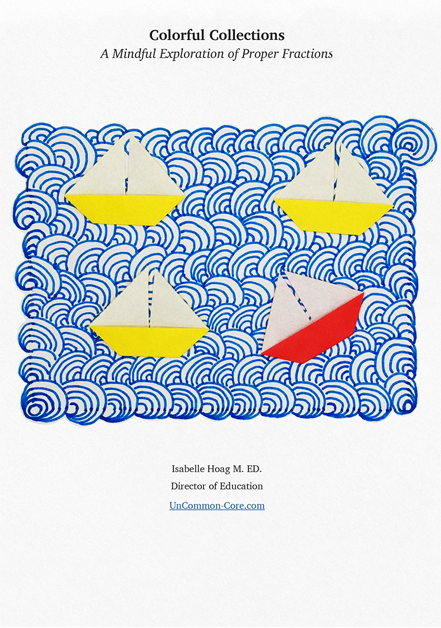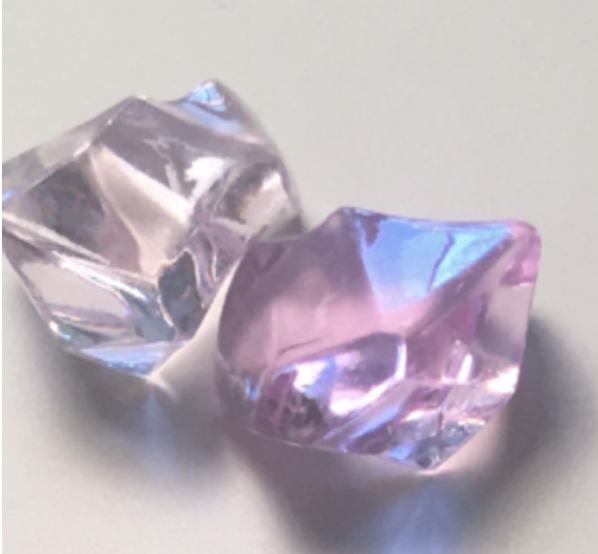
From the First Week to the Last Day of School
Don’t Say it! is a fun math game that can be played with any number of students, many ages, at most any time of the day. You can use it as part of a lesson or whenever you have a few extra minutes to fill. The object of Don’t Say It! is to NOT say a specific number in as many different ways as possible.
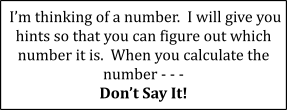
Introducing the Game
Either stealthily write a number on the whiteboard and then cover it up, or tell your class that you are thinking of a number. Explain that when they figure out which number you have in mind, Don’t Say It!.
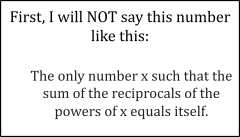 Give your students clues about which number is in your mind, by sharing ways to NOT say that number. Remind them of the name of the game as you play. You might introduce the game with clues so easy that most students will get it right away. Alternatively, you could begin with clues designed to grab their attention and point to more advanced math (such as the skills and concepts that will be taught next week). The game is very flexible. Based on the students in your class, decide which approach is the best way for you to introduce the secret number.
Give your students clues about which number is in your mind, by sharing ways to NOT say that number. Remind them of the name of the game as you play. You might introduce the game with clues so easy that most students will get it right away. Alternatively, you could begin with clues designed to grab their attention and point to more advanced math (such as the skills and concepts that will be taught next week). The game is very flexible. Based on the students in your class, decide which approach is the best way for you to introduce the secret number.
For example, some of the clues throughout this post that have been included to show that the ceiling, the limit to the level of difficulty in this game, is very high. Students of all levels can find ways to challenge themselves and others while playing. Students may create clues according to their interests and strengths: in languages other than English, by jumping or clapping a certain number of times, reciting a couplet, by finding a symbol, or sharing a painting of a couple items.
Playing the Game
Once your students know how to play, they can make this game as easy or as difficult as they want.
After sharing a few ways not to say the secret number invite students to think up some clues. Ask the entire group if they agree that the suggestion is a good way not to say the secret number. Have students use thumbs up or down for ‘yes’ or ‘no’ and thumb parallel to the floor for ‘I don’t know’ to signal their response. This gives you a quick idea of how the students are doing.
Eventually, when you are certain that everybody knows which number is not being said, and everyone has had a chance to share ways to not say it, reveal the number. You might have a countdown to the number and then let everyone say it at once. You might have the students hold up that many fingers, or write it on their papers or dry erase boards. They could whisper the number to their neighbors. This fun math game can be played in many different ways.
 For example; At the start of the game, the students don’t know that six is the number we are not saying. The first way we do not say the number is 5 + 1. The next way we do not say the number is 7 – 1, then 10 – 4, and 2 x 3. At this point, invite the students to think of ways to not say the number. Have the rest of the class indicate approval or concern with thumbs again. This will help students focus on the conversation. They know they will be asked to either agree with or question each way their peers Don’t Say It!.
For example; At the start of the game, the students don’t know that six is the number we are not saying. The first way we do not say the number is 5 + 1. The next way we do not say the number is 7 – 1, then 10 – 4, and 2 x 3. At this point, invite the students to think of ways to not say the number. Have the rest of the class indicate approval or concern with thumbs again. This will help students focus on the conversation. They know they will be asked to either agree with or question each way their peers Don’t Say It!.
As you can see, the fun in this math game is to think up as many ways not to say a number as possible. Yes, part of the joy is recognizing which number is not being said, however, most of the excitement is generated by checking your classmate’s suggestions, and coming up with your own ways not to say the number.
Make the Game Easier
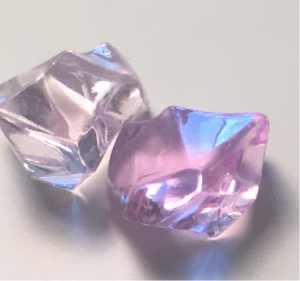 You can differentiate this game in several ways. Why not pair students with different strengths together? You could let students who share a language other than English team up together.
You can differentiate this game in several ways. Why not pair students with different strengths together? You could let students who share a language other than English team up together.
Multilingual students could think up clues in their other languages, then translate them into English.
Once you are sure that everyone knows which number is not being said, give the class three minutes to list all the ways they can think of not to say the number. When time is up, have them share their ideas. Giving students quiet time to generate a list of responses, allows each person to work at his or her own level. Expect some students to write long lists of complicated suggestions and others to come up with shorter lists of more straightforward ideas. This differentiation technique slows the pace of the game, allowing more hesitant or reflective students the time they need to create a contribution.
 It’s always a good idea to have centimeter cubes, counters, or other manipulatives handy so that students can make sure that they or their peers are not saying the number accurately. If needed, spend time discussing how to check clues. You want to make sure that everyone is not saying the same number.
It’s always a good idea to have centimeter cubes, counters, or other manipulatives handy so that students can make sure that they or their peers are not saying the number accurately. If needed, spend time discussing how to check clues. You want to make sure that everyone is not saying the same number.
Most students catch on quickly to the rules of this game. Some might need to play Don’t Say It a few times before they feel confident. If any of your students have math tutors, or work with other teachers when learning math, share Don’t Say It, with those tutors and specialists. In this way, less confident students will have more time to learn how to play and enjoy the game.
Make Don’t Say It! more Challenging
![]() Don’t Say It is a great game to introduce at the beginning of the year in order to get students thinking about all the creative ways they can not say numbers. Then, as you teach new skills, remind your students to use those skills to find more complex ways not to say numbers. You could increase the complexity by introducing a new rule to the game; “From now on, use multiplication or division every time you don’t say this number.” This could also be done informally by encouraging use of the new skill; “How could you use fractions when not saying this number?”
Don’t Say It is a great game to introduce at the beginning of the year in order to get students thinking about all the creative ways they can not say numbers. Then, as you teach new skills, remind your students to use those skills to find more complex ways not to say numbers. You could increase the complexity by introducing a new rule to the game; “From now on, use multiplication or division every time you don’t say this number.” This could also be done informally by encouraging use of the new skill; “How could you use fractions when not saying this number?”
4/2, six-thirds, 8/4, 16/8, thirty-two sixteenths, sixty-four thirty-seconds, 128/64 . . .
Not saying large numbers is another way to increase the level of difficulty. Depending on the topics your class is learning about you can play Don’t Say It with numbers that illustrate those concepts. Is your class learning about prime numbers? Don’t say 97. Are you teaching exponentiation? Don’t say 5³. When studying place value, you might use multiples of ten. When studying decimals, you might use 0.7.
Pay attention to how you encourage students to find increasingly complex ways to not say numbers. Rather than issuing a challenge specifically to members of the ‘top’ math group, thereby reinforcing the idea that there are students who are ‘good’ at math and students who are ‘less good’ at math, open up challenges to any student who wants to try it. Including every student in the challenge gives the message that the teacher believes in all students’ math abilities.  For example, you could invite students to come up with a three step response such as 1+9-4, if they want to give it a try. Let students decide for themselves whether or not they would like to make the attempt.
For example, you could invite students to come up with a three step response such as 1+9-4, if they want to give it a try. Let students decide for themselves whether or not they would like to make the attempt.
Variations
You might want to create a ‘Don’t Say It’ bulletin board. For example, if you want your students to work on multi-step problem solving, or mental math, or the order of operations, or the multiplicative property of one, or all of these at once, you could post clues such as, (20/5) + 2, or (5,639,652 x 0) + (2 x 3). As students complete their daily work, provide them with materials to create their own hints for the bulletin board. Either check their hints and then post them yourself, or set up a system so that student posts can undergo peer review before they are added to the bulletin board. One way would be to require 3 other students to check and initial the hint before it can be posted.
In addition to thinking of numerical clues, invite students to share linguistic suggestions. Let’s say that your class is not saying ‘six.’ Students might share verbal clues like, “seis” in Spanish, “a half dozen,” the number of fingers rumored to be on Anne Boleyn’s right hand, or “the number of legs on an insect.” Including linguistic ways to not say numbers will open up your students’ minds. This contributes to their academic vocabulary building; number of vertices on a hexagon, number of sides on a cell of beeswax, or the number of musicians in a sextet. They will search beyond math for connections to other academic subjects. This also encourages learners to seek out relationships between math and their personal interests or hobbies. Plus, listening to suggestions from their peers may expand students’ thinking, give them new ideas, or help them make new associations.
You could have students play independently in small groups. Alternatively, you could start a new game at the end of class. Once everyone knows the secret number, invite them to list ways not to say it for homework. Let your students teach this game to their family. Playing Don’t Say It! at home will give your students more opportunities to develop number sense, strengthen calculation skills, and enjoy mathematics.
What number have I not been saying?
TWO!
Give Students Time to Reflect on What they are Learning
When your students are experts at figuring out the secret number and then not saying it, challenge them to think about what they have learned by playing this game.
How long do you think it would take to list every single way not to say the number one?Mathematicians think that we can “not say” an even number by adding two prime numbers together – what do you say?If you don’t know which number is not being said, can you tell if it is even or odd? How?What kinds of questions pop into your mind when we play Don’t Say It?
Encourage your students to consider how playing this fun math game might help them in math class.
Students Learn to Decompose Numbers While Playing
Don’t Say It! helps students conceptualize numbers and explore relationships between numbers. It gives them experience in breaking down numbers. For example, when adding 8 and 9, students might want to ‘not say’ the number 8 as 7 + 1. Breaking 8 into 7 + 1, makes conceptualizing the addition problem easier. They can add the 1 to the 9 to get 10 which combines with the 7 to make 17. Other students may simply recognize 8 + 9 as a clue when 17 is the mystery number in a rousing game of Don’t Say It!
Students Get Experience with Equality and Substitutions
Don’t Say It! helps students understand the nature of equality and equations. Knowing that both sides of an equation must ‘balance’ is central to understanding the language and symbolism of math. While direct instruction is needed in order for students to verbalize this idea, number sense games supply tangible examples to support this and other academic concepts. Number sense games provide a variety of informal experiences that connect with and validate the formal study of mathematical topics.
Older students may recognize that Don’t Say It! clues could be substituted for numbers in equations. This will help them work with fractions, for example. If they are solving a problem like 12 minus 8 fifths, students could decide to replace the 12 with 60 fifths to make the problem easier. This kind of substitution will become second nature to students familiar with Don’t Say It! and other number sense games.

Don’t Say It and other number sense games provide students with carefree opportunities to think deeply about numbers and numerical relationships, to make connections between math and other subjects, to gain experience using new skills, mathematical symbols, and academic vocabulary, and time to practice making accurate calculations.
Share This Story, Choose Your Platform!
Download Colorful Collections:
A Mindful Exploration of Proper Fractions
Help your students make sense of fractions.
I started teaching in 1987, which means I’ve collected many tips and tricks along the way. In this ebook, I share concepts, strategies, and classroom materials to help you make math sticky.
Along with this useful ebook, you will receive weekly emails from StickyMath@UnCommon-Core.com. I send information like: teacher tips, educational ideas, book reviews, curated lists, reviews of educational sites, and free first drafts of products that I’m creating for my TPT store. That way, you get helpful ideas and free stuff, while I get some feedback before I finalize products and put them up for sale.
I value your privacy. I will never sell your information. You may unsubscribe at any time.
All the best!
Isabelle
Isabelle Hoag M. Ed.
